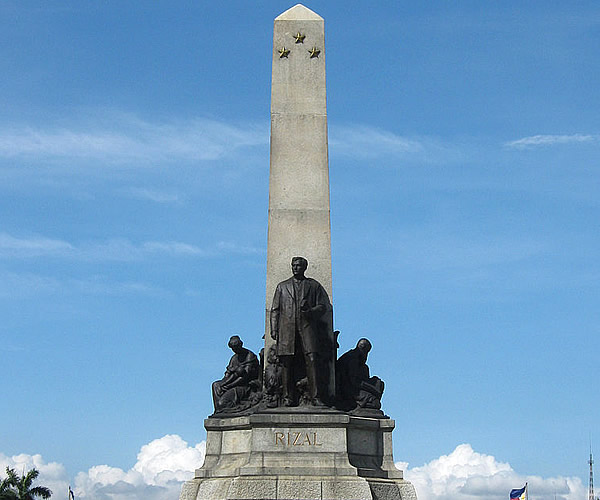
Drink
Drinking is a social pursuit in the Philippines. You'll be invited to socialize over drinks at a local bar or you may be invited for drinks at someone's home. It may be rude to say no and to be polite, you can agree to stay for a round or two of drinks.
Non-Alcoholic
- Water can usually be bought in bottles at the supermarket. You can also order gallons of distilled, filtered or purified water for your home. There are many water delivery stations that do the distillation, filtering or purifying process. Carbonated water is not common. Drinking water from the tap is not advisable as it may not be potable.
- Coffee is a staple drink in the Philippines. There are lots of coffee shops in Manila that serve coffee as well as other beverages and meals. Coffee drinkers usually get their coffee fix in the morning and after lunch. Instant coffee can also be bought in the supermarket and different flavors are available.
- Juice is common in the Philippines. Fresh fruit juices and fruit shakes can be ordered from restaurants. Coconut juice, locally known as buko juice, is a well-known refreshing drink. A hole big enough to fit a straw is cut on the top of the coconut and the coconut is served as is. Other delicious juices include mango, orange, guyabano (custard apple) and pineapple. Check with the restaurant as some fruits may be seasonal and may not be available to order. Fruit juices are also available in supermarkets.
- Tea is not a customary drink in the Philippines. Iced tea is more common as well as milk tea.
Alcoholic
- Beer is the most common alcoholic drink in the Philippines. San Miguel Beer is a popular local brew and has different varieties. Another popular local beer is Red Horse Beer with a sweeter taste and higher alcohol content.
- Hard liquor is an alternative option to beer. Gin and rum are the regular options for hard liquor.
- Local liquor is produced in different parts of the Philippines:
- Tuba is an alcoholic beverage created from the sap of coconut palms
- Lambanog is a distilled version of tuba.
- Basi is a fermented alcoholic beverage made from sugarcane. It is local to the Ilocos region, north of Manila.
- Tapuy is a fermented rice wine. It is a traditional beverage of the mountain regions of Banaue and Mountain Province and is used in ceremonies and other occasions.
Drinking Customs
Filipinos start their drinking sessions by pouring a shot on the ground as an offering to the spirits. When drinking in someone's home, there will be a designated pourer who fills up a single glass which is then passed around. Each drinker is expected to drink from the glass bottoms-up, locally known as "tagay". Filipinos are also fond of eating "pulutan", which are usually deep-fried or fatty food, while drinking.
Liquor Laws
The legal drinking age in the Philippines is 18. It is also illegal to sell alcohol to minors. Drinking alcohol is absolutely banned in hospitals, schools, government offices and public transport.
The penalties for drinking and driving are extremely severe. A driver of a private motor vehicle with a gross vehicle weight not exceeding 4500 kilograms and a blood alcohol concentration of 0.05% or higher shall be conclusive proof that the said driver is driving under the influence of alcohol. The same applies to drivers of trucks, buses, motorcycles and public utility vehicles with a blood alcohol concentration of more than 0.0%.
Eat
Manila has a vibrant dining scene where good eats are offered - from street food to fine dining. Aside from the usual local Filipino fare, there are various other dishes to choose from. Available cuisines include American, Chinese, Japanese, Korean, European and Middle Eastern.
Filipino Specialties
- Adobo - A popular Filipino dish made by boiling chicken, pork or a mix of both in a broth of garlic, soy sauce, vinegar, salt and sugar. There are several versions in different parts of the Philippines.
- Sisig - A sizzling dish of pork head, cheeks and liver perfect as pulutan for drinking. This dish originated in Pampanga.
- Lechon - A staple during fiestas, this suckling pig is spit-roasted until golden brown, with its crackling skin and juicy meat dipped in liver sauce.
- Tinola - This dish is made by cooking chicken in ginger broth and adding in sayote (chayote) or unripe papaya slices and sili (chili) or malunggay (horseradish) leaves.
- Kare-kare - A stew of oxtail and other meat such as beef or pork. What makes it unique is its sauce made from ground peanuts. Vegetables such as banana blossom, eggplant and string beans are also added. It's best eaten with bagoong (shrimp paste).
- Sinigang - A stew soured by tamarind, guava or kamias (bilimbi). Pork, fish or prawns is cooked with onions, garlic and tomatoes then placed in the sour broth. Vegetables such as kangkong (water spinach), string beans and eggplant are also used.
- Tapa - Dried marinated beef usually eaten with sinangag (rice fried in garlic) and fried itlog (egg). The combination of tapa, rice and egg is called tapsilog (tap - tapa, si - sinangag, log - itlog).
- Longanisa - Pork sausage also eaten with sinangag and fried egg. Each province in the Philippines has its own version of this pork sausage, ranging from sweet to spicy to garlicky.
- Turon - A famous Filipino dessert or merienda (snack) made by sprinkling brown sugar on saba banana, wrapping it with lumpia wrapper then deep frying it. Slices of langka (jackfruit) can also be added to give it more flavor and texture.
- Halo-halo - The most popular Filipino sweet treat made by mixing finely shaved ice, evaporated milk, sweetened kidney beans, banana, kaong (sugar palm fruit), gulaman, langka, kamote (sweet potato) and nata de coco. Top it off with a tiny slice of leche flan (crème caramel pudding) and a small scoop of ube (purple yam) ice cream and you have the best treat to cool you off on those hot summer days.
Vegetarian
Vegetarian food is quite difficult to find since Filipinos are commonly meat-lovers. Most restaurants do not offer a vegetarian menu. However, here are some vegetarian restaurants in the metro:
Corner Tree Cafe
Address: 150 Jupiter St., Bel-Air, Makati City
Tel: (632) 897-0295
This cozy café in Makati City serves healthy and hearty vegetarian dishes. Booking in advance is advisable.
Greens Vegetarian Restaurant and Café
Address: 92 Sct. Castor St., 1103 Quezon City
Tel: (632) 415-4796
This café and restaurant provides affordable vegetarian food and refer to themselves as a "genuine lacto vegetarian restaurant" which means no eggs, meat or fish.
Edgy Veggy
Address: 3 Brixton St., Kapitolyo, Pasig City
Tel: (632) 584-9080
This restaurant can be found in the food hub of Kapitolyo. They also offer a food delivery service, perfect for vegetarians who don't have time to prepare their own meals.
SUSI
Address: Forbes Town Rd., Burgos Circle, 1634 Taguig City
Tel: (632) 833-7874
Susi is a Filipino word which translates to key in English. This is the first plant-based restaurant in Manila. They serve modern vegetarian/vegan cuisine, which they say is the key (hence susi) to sustainable living.
Tipping
Tipping in the Philippines is less generous than in other countries like the United States. It is not a customary practice since all meals include a 12 percent VAT (value-added tax). Some restaurants may also add a service charge so check your bill before paying. Locals usually leave a tip of PHP 20. If you've had a pleasant experience and were satisfied with the service, you may choose to leave a larger tip.
It is not necessary to pay a tip for fast food, self-service or take-out meals.
Fast Food
Fast food is widely available in Manila. You can eat in, take-out or have your meals delivered. Fast food restaurants are open as early as 6am for breakfast and close as late as 10pm. Some fast food branches are even open for 24 hours. Fast food meals tend to be cheaper than restaurant meals. You can get a decent meal for PHP 100 or even lower.
- Jollibee - popular local fast food chain known for their chicken and other rice meals
- Chowking - serves Chinese-style fast food meals
- McDonalds - serves burger meals and other rice meals
- KFC - serves chicken and other rice meals
- Wendy's - serves burger meals
- Burger King - serves burger meals
Restaurants
There are varied and numerous restaurants scattered around Manila. Prices vary and are usually expensive in high-end areas such as Makati and Bonifacio Global City. Look for restaurants where locals dine.
Dining Guides
For the best of Manila dining, you can check the following sites:
- Spot.ph has an Eat+Drink section that features top ten lists as well as neighborhood guides for the best eats in town.
- looloo insights features restaurant reviews, top ten lists and foodie guides to areas around the metro.
Restaurant Search and Reviews
For search and reviews of specific restaurants, you can check the following sites:
- Munchpunch allows you to search for restaurants, view their menu and read restaurant reviews and experiences from previous diners.
- Zomato is similar to Munchpunch since it also allows you to search for restaurants, view their menu and read restaurant reviews. An added feature is that it allows you to order online.
- Our Awesome Planet was created by Filipino foodie Anton Diaz. It started as a blog and is now a lifestyle website. Check out the Restaurants section for restaurant reviews.
Areas
- Maginhawa Street - A sprawling foodie hub near UP Diliman, the country's premier state university. Here you can find delicious eats at cheap prices.
- Lilac Street - This Street is a lesser-known but flourishing food center in Marikina, on the northern part of Metro Manila.
- Kapitolyo - This is a residential neighborhood where you can walk around and discover good food.
- Tomas Morato and Timog - These neighborhoods are where Quezon City dwellers eat and party, with the many bars coming alive at night.
- Salcedo Village - Known for its Saturday market, this village also offers tasty dishes in restaurants scattered around it.
- Legaspi Village - This is a residential village in Makati City and has restaurants popular with the office crowds.
- Bonifacio High Street - This Street has a vast array of restaurants mixed with retail stores in Bonifacio Global City, one of the high-end areas in Metro Manila.
- Binondo - Also known as Manila's Chinatown, you can have a taste of truly authentic Chinese food here.
Update 9/06/2016

Babbel is an international success with millions of active subscribers and ranked as the world's #1 innovative company in education.
Why Babbel?
Learn and review on your own schedule: Mobile, tablet or desktop compatible, with lessons about 10-15 min.
Expert-made courses: Learn the basics or focus on topics like travel, culture, or business.
Start speaking right away: Learn to speak a new language naturally and conversationally.
Every learner is different: Each course is based on your native language and personal interests.
Remember everything: Babbel employs proven cognitive techniques that move new vocab to your long-term memory.
Refine your pronunciation: Practise speaking and improve your pronunciation with speech recognition technology.
Try Babbel for free today
Registration with Babbel is completely free of charge and the first lesson in every course is FREE to try (Depending on the language you choose, that's 30-80 free lessons!).
If you want full access to Babbel's courses, simply choose a subscription that works best for you. Buy with confidence: 20-day money back guarantee!
